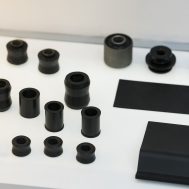We have a lot to say about measuring rubber. When it comes to tolerance (how much change is allowed for a rubber part during the manufacturing process), standards need to be set. The Rubber Manufacturers Association (RWA) has established a set of industry guidelines for specific measurements. Combined with outside factors that impact tolerance, there’s even more to talk about. So, let’s get started.
There Are Levels to This
There are four levels of rubber tolerance: A1, A2, A3, and A4. RMA Designation A1 is considered “High Precision,” which is the strictest tolerance classification. Measurement accuracy is vital for A1, as this designation is often used for tolerances in high-performance applications that demand precision for success, such as in the medical field. Therefore, A1 products may require expensive molds and costly inspection procedures.
The A2 designation is considered “Precision.” This level has the distinction of not requiring the same near-perfect accuracy as A1. Commonly used in areas like the industrial field, A2 needs to be kept in good condition and may require careful inspection. A2 offers the user a balance of production cost and performance, making it a solid choice when pinpoint precision is not required.
A3 is called “Commercial.” Products with this tolerance are the most common for rubber parts out of the four designations. A3 parts do not need the high precision seen in A2 and A1, and as such can be used in more wide-ranging settings, hence the “Commercial” name. A4, known as “Basic,” focuses more on cost-effectiveness than precision and inspection. Tolerance control is another price paid for its lower cost. Still, A4 is an option for when some control on measurements is needed—just not as much as the previous three designations.
Our website hosts a page listing the different levels of tolerance control for the A1 and A2 designations. The webpage also has a PDF with multiple charts that detail o-ring sizes and tolerances.
Factors That Affect Tolerance
Tolerances in molded rubber parts can be affected by various factors. For example, packing rubber for shipment before it sets or improper cooling can change its shape and cause distortion. Hot and cold temperatures can also contribute to distortion. As a result of these factors, it becomes more difficult to accurately measure parts.
Temperature also plays into the greater factor of environmental conditions affecting tolerance. Some variations of rubber can swell from absorbing moisture in the air; as such, humidity should be accounted for. During manufacturing, the environment can alter how rubber flows and settles, affecting the end product. Even at the end of the rubber molding process, the storage characteristics play a part, requiring consideration of temperature, humidity, and the general method of storage.
Another factor is shrinkage. It’s normal for rubber to shrink when it cools. Because shrinkage cannot be eliminated, it has to be considered before molding occurs so the rubber can accommodate it. Additionally, variables like temperature and pressure need to be accounted for because of their ability to incur shrinkage, so it doesn’t come as a surprise later in the process. Different compounds, like natural rubber and silicone, react differently in the process and have their own kind of shrinkage. Mixing weight tolerances can also affect shrinkage with the same compound from lot to lot.
As you’ve read, the factors impacting rubber tolerance are important to know because of the need for safety and functionality across rubber’s various uses. Whether it’s the medical or industrial field, the type of tolerance and measurements are important to know. That’s why the four designations of A1, A2, A3, and A4 are so important.
Reach Out
If you’re looking for help on your next project, contact us.
